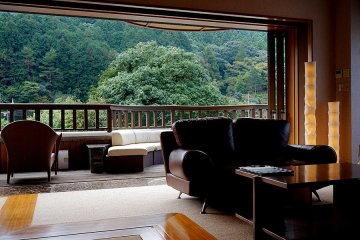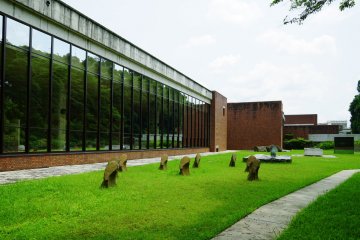Kozan Park in Yamaguchi contains three historical landmarks, the park itself, Toshunji Temple, Rurikoji Temple and Pagoda. These peaceful havens contrast with their origins in periods of internecine war and conflict between the 14th and 19th centuries.
Toshunji Temple and its buildings has an air of faded dignity about it, with its sombre, plain wood carvings. It was built to honour a great Japanese warlord of the mid-16th century. Its Sanmon Gate, built in 1400, remains one of the few temple gates with four sturdy pillars. Kannon is worshipped in an adjacent shrine.

The fun begins in a rustic enclosure at the side of the Main Hall. Think a zebra wannabe, that is a horse draped in a zebra jacket, a happy lad chopping pumpkins, a pottery. The centre piece is a Buddha-like sculpture constructed of tiered layers of planks, each crowded with tiny figurines.

Rurikoji Temple’s grounds can’t be rushed through with its variety of religious accoutrements and statues. Standing guard just outside the Main Hall are a giant wooden rice scoop and wooden pestle, down the steps a tripod sculpture of tree branches.

A metallic sheet mounted on a stone displays two footprints of Buddha with intriguing religious symbols etched on. The large bell tower holds its own with its wooden stripped base, ensconced by thick bushes.

The much acclaimed five storied Pagoda is being renovated and draped in plastic, but its reflection in the pond is impressive enough for us to imagine the Pagoda in its full uncovered glory. Built by a younger brother as a memorial for his older brother killed in battle in 1399, it was completed in 1442.
Kozan Park is unsurprisingly peaceful, being after all the resting grounds of the Mori Clan (1603-1867), then early influencers of the Meiji Restoration (1868). Carved stone lanterns are plentiful, symbolizing perpetual light, reminders that Kozan is holy ground.

Nearby are a few other commemorative monuments, noteworthy being the horseback statue of Ouchi Hiroyo (1326–1380). He was so enamored of Kyoto he just had to develop a town to duplicate it, and there it was in the Yamaguchi basin, Yamaguchi. A resting spot for living humans would be the area and pond by two Edo type houses, Chinryutei and Rozando, both useful disguises for clandestine meetings held by Meiji Restoration supporters.

A change of scene comes at the Nightingale Path. Hopefuls optimistically clap hands and stomp on the ground to hear a nightingale sing. A phenomenon of nature is a pine tree growing out of a crape myrtle tree. They are light hearted attractions after the drama of the memorial sites and their roots in war and death.
Kozan Park is a microcosmic segment of Japan’s history, ensuring at least a memory of the war heroes who radically changed Japan’s course from the 14th century onwards. There’s a feeling of What If when one leaves.
















